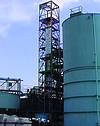
Adroit Technologies, long time market leader in the continuous process industry and pioneering designers in the field of scada systems, has partnered with FutureMet in a project to develop and install the world’s first continuous counter current resin contactor (CCCRC) – a FutureMet innovation that dramatically reduces the cost of resin in pulp (RIP) applications for various industries, and particularly for treating residues at base metal refineries.
Base metal refineries continually battle the law of diminishing returns when it comes to increasing metal recovery efficiencies. Employing industry standard hydrometallurgical technology still leaves effluent slurry streams with residues norms estimated to contain between one and five percent dissolved heavy metal. Resin in pulp (RIP) technology, on the other hand, can easily be 99.99% effective in the extraction of dissolved metals, but has never been used due to the prohibitive costs (both CAPEX and OPEX) associated with RIP plants employing contemporary RIP technology.
These costs, from a CAPEX point of view, can largely be attributed to the need for a large amount of expensive process plant equipment such as screens, pumps, large agitated tanks, sequencing valves, and a start-up inventory of hundreds of tons of resin. From an OPEX perspective, these plants would require a large number of operations personnel and a further resin inventory, as a consumable item, equal to 70% p.a. of the initial start-up resin inventory.
It was with this in mind that FutureMet created the world's first continuous counter current resin contactor (CCCRC), a self-contained device in which all four stages of the RIP process occur, namely loading the dissolved metal onto resin stage, the pulp-washing stage, the acid stripping stage and the acid wash stage. The device has no moving parts and the resin is not pumped or washed across screens, therefore degradation of the resin is virtually eliminated. Also, being a self-contained device, there is no place for the resin to fall out and be lost.

When compared to a conventional RIP plant, a plant employing the CCCRC technology would require one-fifth of the capital expenditure of the conventional technology plant. Comparing the OPEX requirements, the CCCRC plant would use less than one-tenth that of the conventional plant. Because of the very low CAPEX and OPEX demands, the payback period for a plant using CCCRC technology is very short.
Tim Victor, a director of FutureMet, comments, "The CCCRC is suitable for any resin in pulp or resin in liquid (RIL) application. Application examples it would be suited to include (but are not limited to) certain solvent extraction processes, water desalination processes, water demineralisation processes, certain filtration processes and metals separation processes, and it can even be considered for some molecular recognition technology applications. It can be used for mine dump and slimes dam metal recovery and rehabilitation, and of course it can be used to recover the remaining metals in the residue or effluent streams before they report to the slimes dam or waste dump."
After creating and testing a 2 metre high laboratory scale working model (and taking out international patent protection on the technology), FutureMet felt confident about taking the CCCRC to a local zinc refiner who agreed to facilitate the project by providing premises for the pilot plant. This semi-industrial scale CCCRC measures 1 metre diameter and 21 metres in height and is equal to a quarter-scale model of what a full-scale system would be. A full-scale model would also measure 21 metres in height but would be 2 metres in diameter.
The IDC and FutureMet provided funding for the project and others who have recognised the value in this project, and have contributed towards it, include Rohm & Haas who provided the resin, instrumentation by Endress+Hauser, construction by way of Genrec and advanced control and fuzzy logic engineering by Iritron as well as many other companies who believed in the project and provided favourable rates for various goods and services. As a result of this partnership arrangement, the pilot project's initial estimated cost of almost R5 million was reduced to just over R3 million.
The pilot plant has been hot commissioned and is now commencing a three to four-month evaluation period. FutureMet's objective is to reclaim more than 99% of remaining dissolved heavy metals from the zinc refinery's leach residue slurry.
Victor emphasises, "Any slimes dam that contains dissolved heavy metal is an enormous environmental liability to the owner. This technology's ability to provide a cost-effective heavy metals recovery solution, is possibly worth more to the owner for relieving him from the environmental liability, than the extra revenue received for the additional metal recovered. It is recognised world wide that slurries containing dissolved heavy metals are a potential disaster for the environment, and as a result several base metal refineries overseas have been threatened with closure by their respective governments, unless they meet very demanding environmentally friendly emission control legislations."
With the eyes of the world focused on the recent World Summit on Sustainable Development, triple bottom-line reporting, tightened local government regulation and legislations, as well as numerous government initiatives including such recent developments as the ISO 1400, South African companies may indeed find the eco-benefits of the CCCRC to be a competitive advantage.
Tim Victor, FutureMet, 082 894 4608, [email protected]
| Tel: | +27 11 658 8100 |
| Email: | [email protected] |
| www: | www.adroitscada.com |
| Articles: | More information and articles about Adroit Technologies |

© Technews Publishing (Pty) Ltd | All Rights Reserved